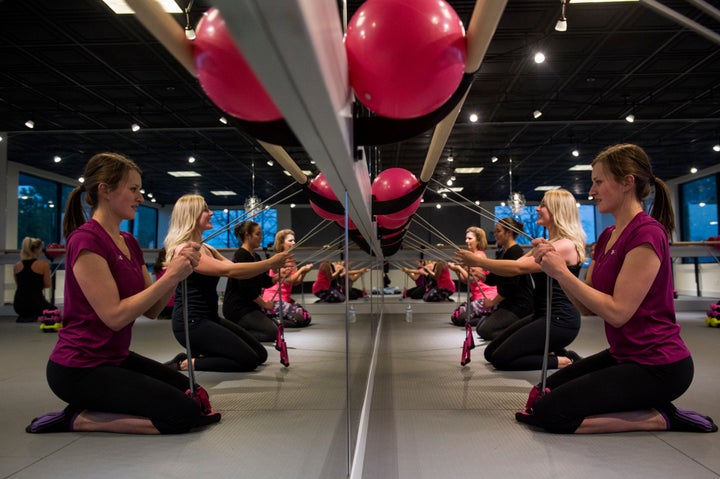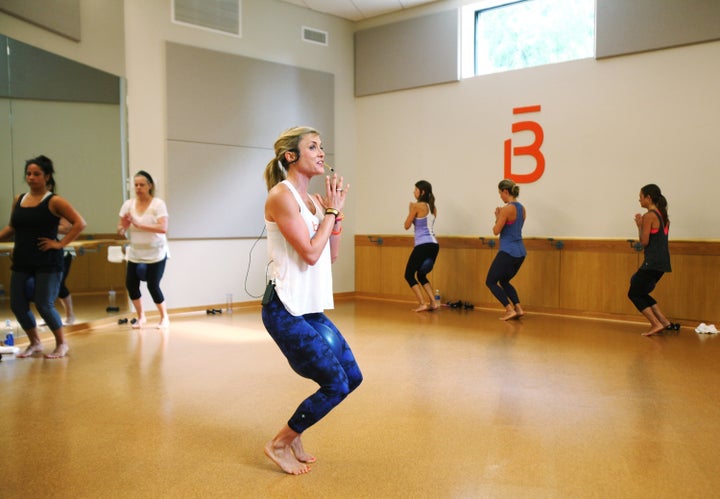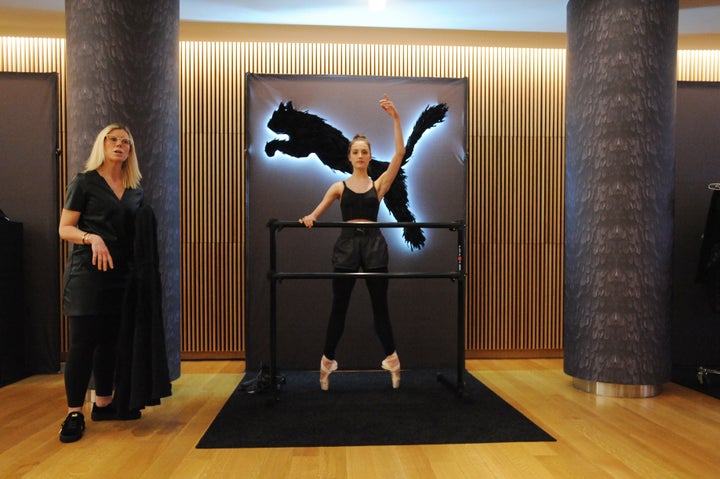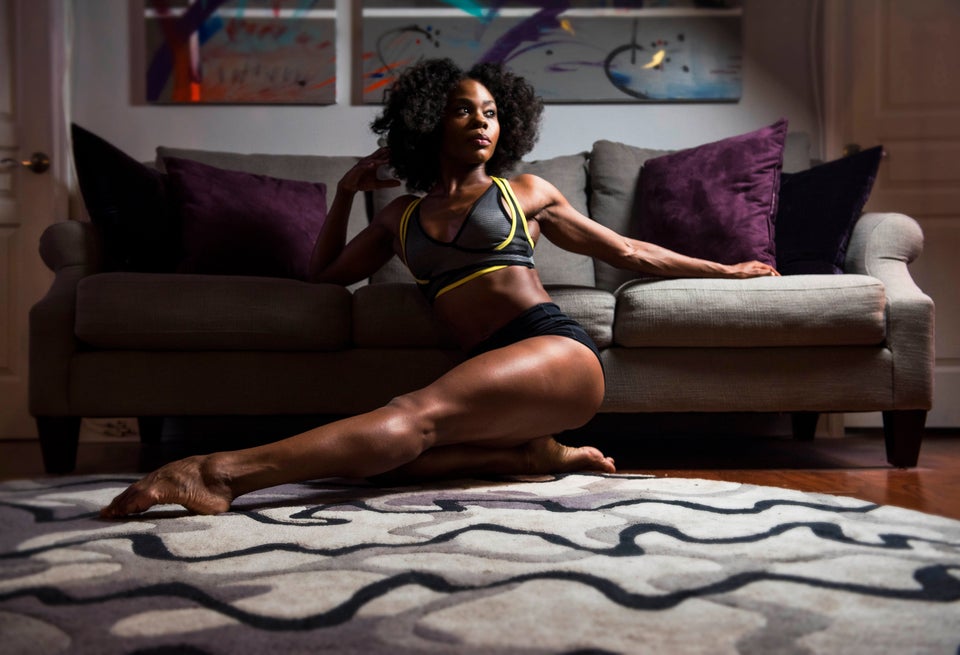
It’s 5 p.m. on a Wednesday, and the exercise studio is starting to fill up. Participants are filtering in, each of them claiming a place at the ballet barres that are bolted to floor-to-ceiling mirrors along every wall. There’s not a leotard or a pair of tights in sight; everyone’s wearing running leggings and t-shirts. Their hair is in ponytails, not stiff ballet buns. And the music that soon starts pumping through the speakers is not classical piano, but pulsating EDM and Rihanna remixes. This looks like a ballet studio, but there’ll be no ballet happening here today. Welcome to barre class.
Ballet is having a cultural moment right now. From Misty Copeland’s crossover into mainstream celebrity to the proliferation of barre classes and the use of ballerinas as models for athleisure and fashion lines, ballet is once again fashionable and aspirational.
As a fashion influence, ballet has come and gone for decades: legwarmers cycle in and out of style, and American Apparel spent years trying to convince hipsters everywhere that leotards are comfortable. Ballerinas from New York City Ballet and American Ballet Theater are currently serving as models for luxe clothing brands like Wolford, Thakoon and Negative Underwear. But ballet’s current mainstream moment goes beyond fashion, crossing over into fitness culture and serving as a revealing reminder of the kind of female athleticism ― the kind of female bodies ― that American culture deems acceptable and admirable.
This is not surprising. After all, the ballerina is the perfect emblem of our anxieties and aspirations around female athleticism: she’s fit and physically strong, but she also bears a striking resemblance to a catwalk model. The ballerina, as most of us envision her, is everything women are encouraged to aspire to be: thin, ultra-feminine, wealthy and white.
Let’s start with barre classes, the blend of pilates, yoga and basic dance moves, some of them done while holding on to the same kind of barre that ballerinas use while warming up and strengthening their bodies at the start of every ballet class.
Barre has spiked in popularity in the last several years, with Pure Barre and Barre3 franchise studios popping up all over the country. Barre was “the breakout trend for 2016,” said Ashley Hennings, the Head of PR at Class Pass, in an email to The Huffington Post. Hennings says that last year, barre accounted for 17 percent of all classes booked through the subscription program, and saw the highest yearly increase in bookings of any fitness category.
Barre bears little resemblance to what ballerinas do in a ballet studio: It’s a lot of squats, there are exercises that require free weights and inflatable balls, and the music is for getting you pumped, not for dancing.
Promotional copy for Pure Barre promises “a full-body workout concentrating on the areas women struggle with the most: hips, thighs, seat, abdominals and arms,” and reassures that “each strength section of the workout is followed by a stretching section in order to create long, lean muscles without bulk.” Barre3’s copy says the workout “mixes athleticism, grace, and the latest innovations designed to balance the body,” and promises that it will “tone and lengthen all major muscle groups,” resulting in “proportion in the body that is shapely and attractive.” It purports to improve your posture, too, presumably to help you to stand tall and regal, like an elegant ballerina. The words “long” and “length” appear a lot on the Barre3 website. “Lean, not bulky, muscles” are the goal here. “The technique works to defy gravity by tapering everything in and lifting it up!” the Pure Barre website assures, perkily.

Long, lean, lengthy, lean muscles that definitely aren’t bulky don’t come cheap.
In New York City, a class at Barre3 will run you $33 for an hour of exercise. In Dallas, a single Pure Barre class costs $22, with discounts if you buy a package of classes. Classes are tailored to their markets, so a single class in Fayetteville, Arkansas, is $15. And a monthly subscription for online Barre3 workouts, complete with recipes and a chat function to consult instructors, is $29. Pure Barre recommends that beginners start by taking four classes a week “for optimal results.”
Then, there’s the gear: studios sell workout wear, weights and balls you can use at home, plus special socks purported to improve your grip and balance during a class that most people do wearing regular socks, or nothing at all, on their feet. The workout wear is pricey, too: There are $56 cotton tank tops and $98 leggings. The “grip sox” are $16.
The gear isn’t mandatory or necessary, of course, but it is part of what the Pure Barre website explicitly calls “more than just a workout ... a lifestyle.” Barre life isn’t just about the squats. It’s about the gear, about carving out time for you, about doing exercises designed for women and taught by women. This is about “creating” a particular kind of female body ― one that is strong but not bulky ― and living a particular kind of feminine life. An expensive one.
Purity or proximity to classical ballet aside, barre classes do claim to offer participants a way to sculpt a ballerina-esque body. Despite its tenuous connections to actual ballet, barre uses the promise of a ballerina body to market to customers (Pure Barre was founded by a former dancer; while the founder of Barre3 describes herself as “renowned wellness expert” and “media personality”).
Barre studios are not the only ones in the fitness industry who are doing so. With the rise of athleisure, brands have begun hiring ballet dancers to help them market apparel for the gym, yoga, running and other workout activities. New York City Ballet principal dancer Sara Mearns serves as a model for Cole Haan’s recently announced athleisure line. Fellow principal Lauren Lovette models for athleisure line MPG Sport. New York City Ballet corps de ballet member Olivia Boisson models for Puma, and the brand just released a Swan Lake-themed line of workout and athleisure gear, created in partnership with City Ballet and modeled by their dancers. American Ballet Theatre soloist Calvin Royal III models for GapFit, along with a racially diverse set of ballerinas. And American Ballet Theatre principal Misty Copeland has a high-profile endorsement deal with Under Armor.
There are many forms of exercise that require, or seem to require, the kind of athleisure wear that has been embraced by retailers and celebrity merchandisers at a staggering rate in the last few years. And there are many forms of exercise that will give you, or promise to give you, the kind of long, lean muscles advertised by barre studios charging $30 per class. Plenty of workouts will leave you looking athletic, muscular, toned ― all those words that reveal the truth behind the “strong is the new skinny” movement, which is that, in addition to being strong, you should still, wherever possible, please be skinny. Yet it’s ballerinas who are increasingly modeling the athleisure wear, and it’s barre classes that are spiking in popularity.
The choice of the ballerina’s body as a way to market exercise gear ― and of ballet as a marketing tool for exercise classes (excuse me, “lifestyles”) ― is not coincidental.
The rise of athleisure highlights the extent to which a body that is regularly exercised has become a status symbol. Athleisure wear, which gives one the appearance of always heading to or from a gym, and reveals your size and shape and musculature in a way that regular street clothes do not, is one means by which to flaunt that status symbol. At a time when, for women, wealth and low weight are correlated, and where poverty and obesity often go hand-in-hand, athleisure wear, and the body you’re clearly meant to have or aspire to when you’re wearing it, is not just about having the right kind of female body ― it’s also about having the right kind of bank account with which to dress it.
It makes sense, then, that ballerinas would be recruited to market athleisure wear and the barre classes for which you supposedly need it: Ballet is, in the public imagination, an activity for the elite. It’s not only the ballerina body that’s aspirational; so, too, is the economic status that the art form of ballet itself suggests.
In the U.S., ballet – watching it and doing it – has long been viewed as an elite activity. In her book Nutcracker Nation, dance historian Jennifer Fisher writes that there is a “rarefied elegance” associated with the art form, which has an “aristocratic subcode” and a “tony profile.” Ballet has a “perceived exclusive quality ... conferring on its participants the gloss of something ‘high class.’” She describes a mid-1990s documentary in which a fundraiser for London’s Royal Opera House called elitism “one of [her] biggest selling points.”
“We like it because it’s elitist, that’s why people come here,” the fundraiser says. “Part of what makes this place special is that the audience is special.”
This attitude is implied in the U.S.’s grand ballet spaces, like Lincoln Center and the Kennedy Center, and Fisher notes that it applies to both watching ballet and to learning it: in her ethnographic research, people repeatedly referred to ballet “as a ‘classy’ thing to do.”
This perception is rooted in fact: Ballet tickets and ballet training are expensive. Even the cheapest tickets to a premiere company like New York City Ballet can cost close to $50. Ballet classes and gear are costly, too, especially as children grow quickly out of leotards, tights and shoes. Pointe shoes start at about $50. This is to say nothing of the cost of performance costumes, competition fees and, for very advanced students, room-and-board at full-time residential ballet schools.
All in all, ballet is not simply perceived as a feminine pursuit, but as one for wealthy women and girls. No wonder, then, that ballerinas – so strong and lean, so athletic in their pricey leggings and racer-back tank tops, so fancy – would be used to market athleisure and fitness classes. They’re a way to sell apparel and exercise by advertising aspirational upper-class feminine beauty.

And that upper-class feminine beauty is white.
The archetypal ballet dancer, in the public imagination, is not only a woman ― she’s a white woman. That’s largely because of the whiteness of the ballerinas who, historically, have risen to the top of the ballet world and become known beyond it. True, there are notable exceptions, reaching back to the beginning of American ballet: Maria Tallchief, widely considered the U.S.’s first ballet star, was Native American. Still, those exceptions are just that: deviations from the norm. The norm in ballet, particularly in the highest ranks and the most prestigious companies, is white.
The most obvious contemporary exception to that norm is, of course, Misty Copeland, the first black woman to become a principal dancer at the American Ballet Theatre. There are other visible exceptions – New York City Ballet’s Boisson and American Ballet Theatre’s Courtney Lavine (who is the face and body of an Avon perfume) – but Copeland is by far the nation’s best-known ballerina, of any race. In addition to her documentary, her several books and her leotard line, which are marketed at dancers, she has her more mainstream endorsement deal with Under Armor and another with Seiko. She’ll appear in Disney’s live-action Nutcracker movie, and she has her own Barbie. She has emerged as a ballet star, a civil rights figure and a celebrity of sorts. Still, her celebrity and her visibility rest not just on her talent, but also on her status as an outlier in the world of ballet. She is a principal because she is a terrifically talented, hardworking and beautiful dancer; she is famous because she is the only black woman in a world of white ballerinas.
Exceptions aside, ballet remains, in reality and in the public imagination, overwhelmingly white. And GapFit notwithstanding, the ballerina body that is deployed to market athleisure gear is usually a white one, and the aspirational lifestyle that is marketed via ballet-adjacent barre classes is implicitly for white women. While the websites for Pure Barre and Barre3 splash sleek professional photos of ethnically diverse classes, the roster of barre enthusiasts who say the regimen has changed their lives for the better is almost entirely white. Barre classes may be a new and growing trend, and ballerina-fronted athleisure may be booming like never before, but scratch the surface of ballet’s new visibility, and there’s very little that’s novel about it.
For those who love ballet and prefer it to be present in mainstream culture, rather than cosseted away in what Fisher calls its usual “swank milieu,” it’s tempting to be cheered by its current popularity and prominence. Now, for the first time in perhaps a generation, ballerinas are visible and accessible to mainstream audiences, held out as role models and as actual models.
But it’s worth looking closer at how the idea of ballet, and the bodies of ballerinas, are being used to sell women on an acceptable vision of feminine athleticism ― one that’s muscular but not bulky, strong and skinny ― and on a version of femininity that promises a body, and a lifestyle, marked by wealth and by whiteness. The goal of all that squatting and pulsing remains unchanged, the costume of athleisure leggings and fitted hoodies is for the same desired performance: be thin, be rich, be white. Be the right kind of woman.
As barre enrollments around the country swell and athleisure brands proliferate, you have to ask: Isn’t this just the same old dance we’ve always done?
CORRECTION: A previous version of this article misidentified Fayetteville as a city in Arizona. We regret the error.

